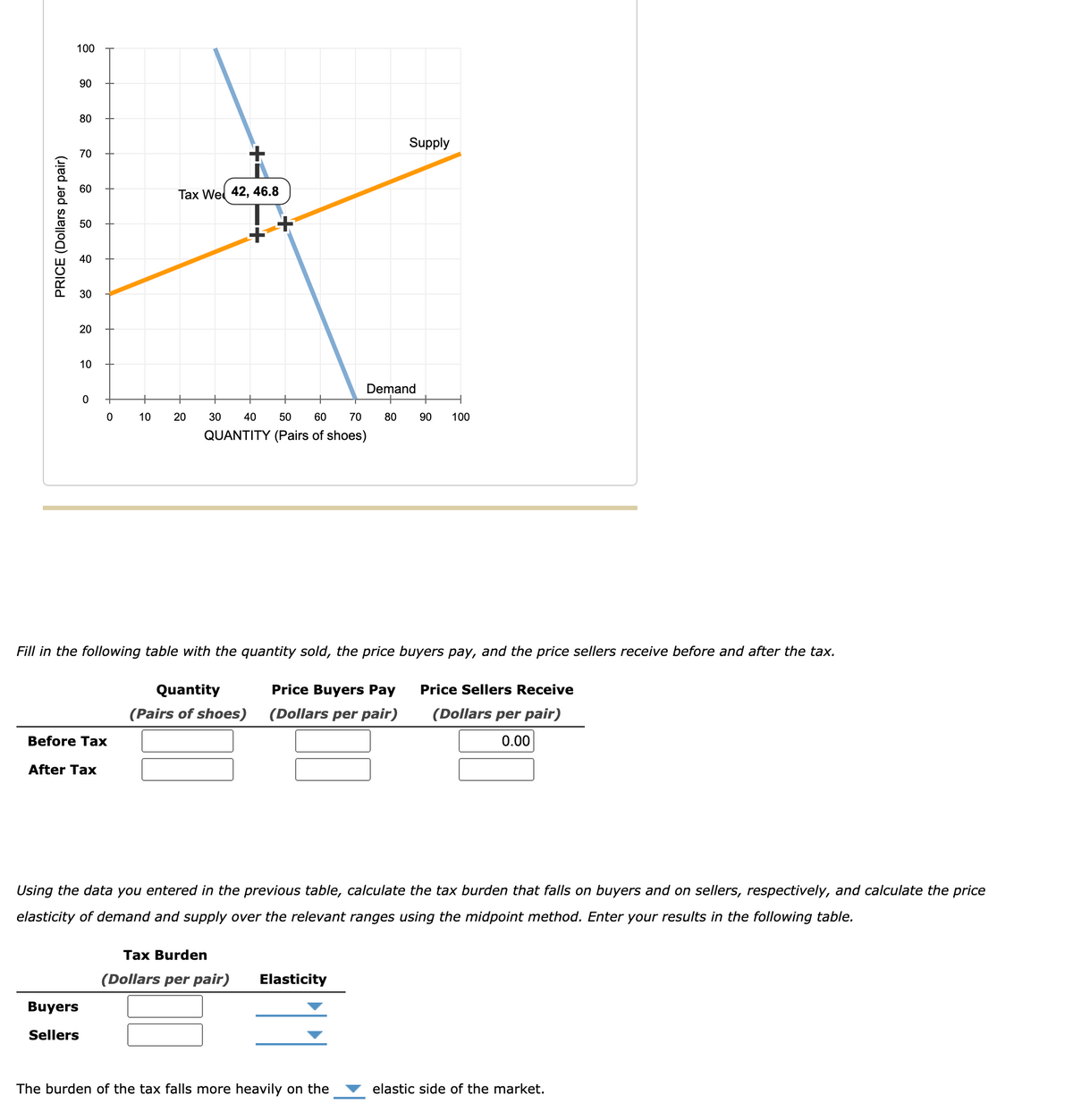100 90 80 Supply 70 60 Tax Wel 42, 46.8 50 40 30 20 10 Demand 10 20 30 40 50 60 70 80 90 100 QUANTITY (Pairs of shoes) Fill in the following table with the quantity sold, the price buyers pay, and the price sellers receive before and after the tax. Quantity Price Buyers Pay Price Sellers Receive (Pairs of shoes) (Dollars per pair) (Dollars per pair) Before Tax 0.00 After Tax Using the data you entered in the previous table, calculate the tax burden that falls on buyers and on sellers, respectively, and calculate the price elasticity of demand and supply over the relevant ranges using the midpoint method. Enter your results in the following table. Tax Burden (Dollars per pair) Elasticity Buyers Sellers The burden of the tax falls more heavily on the elastic side of the market. PRICE (Dollars per pair)
100 90 80 Supply 70 60 Tax Wel 42, 46.8 50 40 30 20 10 Demand 10 20 30 40 50 60 70 80 90 100 QUANTITY (Pairs of shoes) Fill in the following table with the quantity sold, the price buyers pay, and the price sellers receive before and after the tax. Quantity Price Buyers Pay Price Sellers Receive (Pairs of shoes) (Dollars per pair) (Dollars per pair) Before Tax 0.00 After Tax Using the data you entered in the previous table, calculate the tax burden that falls on buyers and on sellers, respectively, and calculate the price elasticity of demand and supply over the relevant ranges using the midpoint method. Enter your results in the following table. Tax Burden (Dollars per pair) Elasticity Buyers Sellers The burden of the tax falls more heavily on the elastic side of the market. PRICE (Dollars per pair)
Principles of Microeconomics
7th Edition
ISBN:9781305156050
Author:N. Gregory Mankiw
Publisher:N. Gregory Mankiw
Chapter6: Supply, Demand And Government Policies
Section: Chapter Questions
Problem 10PA
Related questions
Question
question attached!

Transcribed Image Text:100
90
80
Supply
70
60
Tax We 42, 46.8
50
40
30
20
10
Demand
+
+
10
20
30
40
50
60
70
80
90
100
QUANTITY (Pairs of shoes)
Fill in the following table with the quantity sold, the price buyers pay, and the price sellers receive before and after the tax.
Quantity
Price Buyers Pay
Price Sellers Receive
(Pairs of shoes)
(Dollars per pair)
(Dollars per pair)
Before Tax
0.00
After Tax
Using the data you entered in the previous table, calculate the tax burden that falls on buyers and on sellers, respectively, and calculate the price
elasticity of demand and supply over the relevant ranges using the midpoint method. Enter your results in the following table.
Tax Burden
(Dollars per pair)
Elasticity
Buyers
Sellers
The burden of the tax falls more heavily on the
elastic side of the market.
PRICE (Dollars per pair)
Expert Solution
This question has been solved!
Explore an expertly crafted, step-by-step solution for a thorough understanding of key concepts.
This is a popular solution!
Trending now
This is a popular solution!
Step by step
Solved in 3 steps

Recommended textbooks for you

Principles of Microeconomics
Economics
ISBN:
9781305156050
Author:
N. Gregory Mankiw
Publisher:
Cengage Learning

Principles of Economics (MindTap Course List)
Economics
ISBN:
9781305585126
Author:
N. Gregory Mankiw
Publisher:
Cengage Learning

Principles of Microeconomics (MindTap Course List)
Economics
ISBN:
9781305971493
Author:
N. Gregory Mankiw
Publisher:
Cengage Learning

Principles of Microeconomics
Economics
ISBN:
9781305156050
Author:
N. Gregory Mankiw
Publisher:
Cengage Learning

Principles of Economics (MindTap Course List)
Economics
ISBN:
9781305585126
Author:
N. Gregory Mankiw
Publisher:
Cengage Learning

Principles of Microeconomics (MindTap Course List)
Economics
ISBN:
9781305971493
Author:
N. Gregory Mankiw
Publisher:
Cengage Learning

Principles of Economics, 7th Edition (MindTap Cou…
Economics
ISBN:
9781285165875
Author:
N. Gregory Mankiw
Publisher:
Cengage Learning